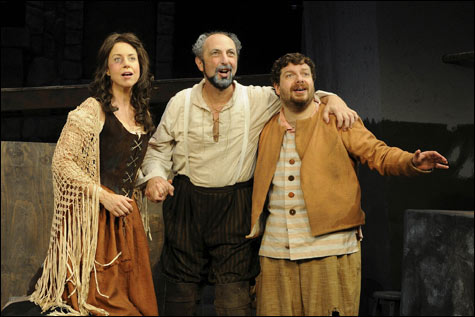
DO YOU SEE WHAT I SEE? An uplifting moment in Man of La Mancha. |
The musical Man of La Mancha certainly packs in a lot. It conflates the attitudes of author Miguel de Cervantes Saavedra and his main characters in Don Quixote, builds everything to a culminating, crowd-pleasing anthem of optimism, and even throws in a nail-biting (though misleading) persecution by the Spanish Inquisition along the way.
The Ocean State Theatre Company is staging the show at Theatre by the Sea (through July 16) with good production values and brisk energy, directed by Amiee Turner. The 1965 Broadway hit was written by Dale Wasserman, with music by Mitch Leigh and lyrics by Joe Darion and Leigh. The show was based on a television production from six years earlier, which lacked the music but came up with the author-character overlap.
An energetic staging is particularly necessary because everything takes place on scenic designer Mark Halpin's single set, a dungeon. Well, it's the spacious anteroom above some dungeons, composed of stones you can imagine weeping dankly with the inhabitants, mostly thieves and murderers awaiting trial. (What's with the massive functionless spikes on the drawbridge-door? Scrawled insulting slogans would intimidate the prisoners better.)
Cervantes (Bruce Winant) and his servant (Robert Anthony Jones), who also plays Sancho Panza to Cervantes's Don Quixote, are there awaiting summons by the late-16th-century Holy Inquisition. The author fears being accused of opposing the church in his writings. (In reality, Cervantes was excommunicated by the Inquisition for being overly enthusiastic as a tax collector, mentioned in the musical. He had too much sense to condemn the Church in his writings, settling for continual parodic jabs.)
Equally worrying to Cervantes, if not more so, is the fate of the unpublished manuscripts he has with him. They are threatened with being burned by the self-proclaimed Governor of the prisoners (JP Sarro), and will survive only if Cervantes is acquitted in a mock trial. Fortunately, he has his costume trunk and can entertain his jury by performing Don Quixote, recruiting them to play the parts.
An old man named Alonso Quijana (Winant) has read so much about chivalry that he imagines himself to be the eponymous Quixote, knight errant and idealistic righter of wrongs. The first "heroic" act that we see is the one we all identify with him, as his old eyes mistake a windmill for a giant with four flailing arms. After attacking it off stage with his tree-sapling lance, he returns bedraggled but unrepentant.
Unusual in a musical, the romance in the story is chaste, though as convoluted as ones in real life. Aldonza (Christine Rowan) is a cynical barmaid and prostitute, and Rowan solidly delivers a gut punch in "It's All the Same" ("I don't know why or who's to blame/I'll go with you or your brother/It's all the same, it's all the same"). Quijana/Quixote refuses to accept that she is not his idealized fair maiden, Dulcinea.